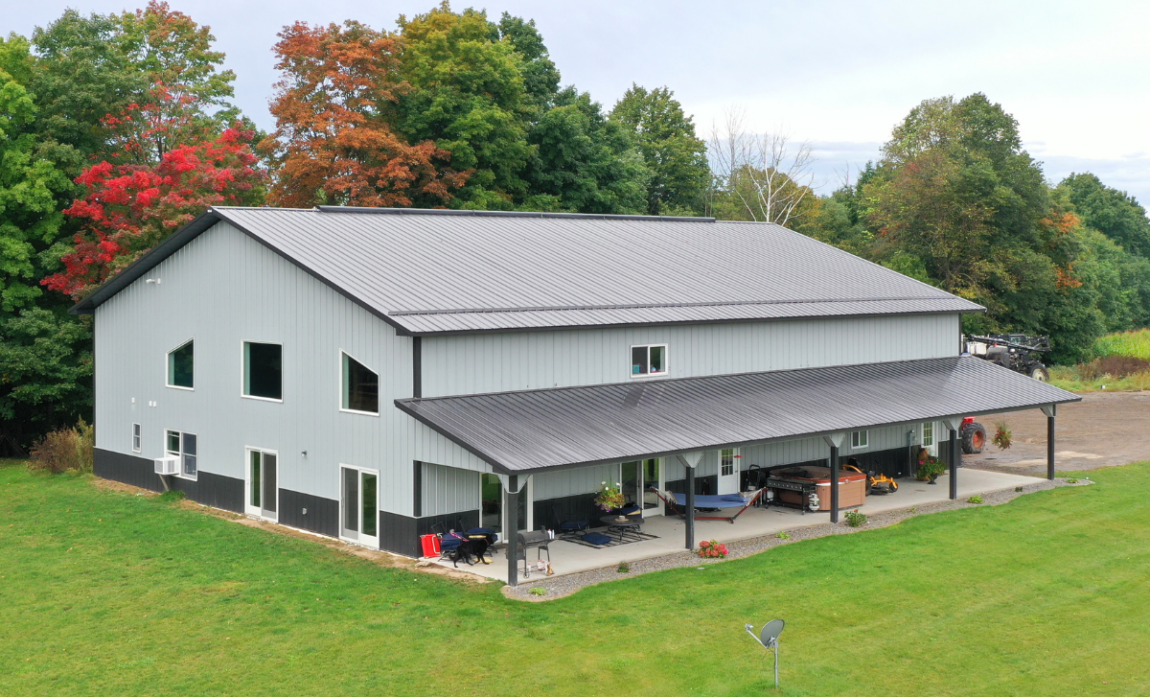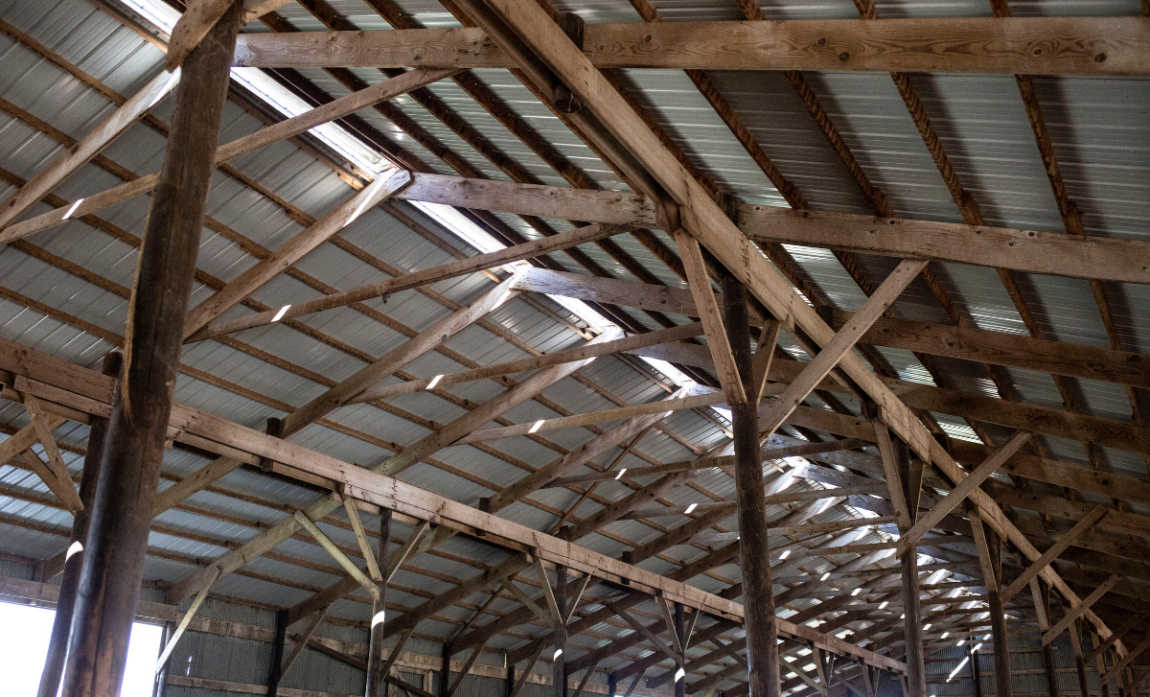Planning your pole barn construction project takes a lot of time. But if you have more time on your hands than usual, why not start that planning now? Below, we’ll provide 14 tips to help you plan smarter, prevent project disasters, and create a smoother path to the pole barn building of your dreams. (We’ll also give you a bunch of helpful resources.)
But first, let’s be clear on what we mean by a pole barn building. Also referred to as a post-frame building, these structures use a specific type of framing system, namely laminated wood posts that transfer wind and snow loads to the foundation.
Pole barns work great for a variety of uses like horse stables, business storefronts, backyard garages and workshops, and she sheds and man caves. Check out this page for a helpful overview.
Okay, now that you’ve gotten pole barns in a nutshell, let’s dive into those 14 tips so you can start planning!
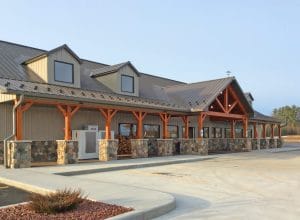
1. Establish What Kind of Building You Want
What are you going to use your building for? That may seem like an obvious question, but it’s easy to get ahead of yourself and skip over critical considerations. So, first things first. Decide which type of building you want:
- Suburban (e.g., garage, workshop, man cave, she shed, home or shouse)
- Equestrian (e.g., stall barn, arena, run-in shed or combination)
- Agricultural (e.g., livestock housing, feed storage, equipment storage, workshop or a combo)
- Commercial (e.g., office, warehouse, mini-warehouse, light industrial or retail)
Clearly establishing this upfront will drive crucial decisions on things like building materials; building dimensions and door sizes; and insulation, electrical, HVAC, and plumbing needs. We’ll explore some of these in more detail below.
Need more information on the benefits of pole barn buildings? Check out Pole Building vs Stick-Frame: 12 Reasons Why Post-Frame Construction Wins.

2. Know Your Zoning Laws, Building Codes, and Neighborhood Covenants
You may think you have the right to build anything you want, but the simple fact is that, legally speaking, that’s not necessarily true. One homeowner in rural Illinois learned this the hard way.
A judge ruled his pole barn building was in violation of both county zoning ordinances and homeowner association covenants. That meant the 9000-square-foot structure, which was nearly complete, had to be taken down.
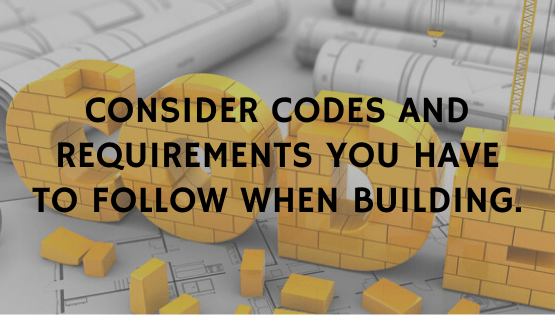
There’s an important lesson there: Don’t get too far down the planning path before you consider the official side of construction—i.e., the codes and requirements you have to follow when building.
These will vary depending on the neighborhood, municipality, and state in which you live, as well as the type of structure you plan to build. Follow these five steps to help ensure you’re in compliance:
- Know your zoning laws
- Research the building codes
- Check with your local municipality for ordinances
- Check your neighborhood covenants
- Meet with the fire marshal
For more details, check out Failing to Know Zoning Laws, Building Codes and Neighborhood Covenants Can Cost You Bigtime.
3. Visualize by Looking at Examples
The easiest way to start envisioning your own post-frame building is by looking at what others have done. Pinterest and Google Images are handy sources for doing that.
But you’ll probably have even better luck if you search the photo galleries of post-frame construction companies. They usually have examples conveniently categorized and you can easily click through them.
One caveat: Don’t be limited by what you see. If you opt to use a builder’s services, the best companies place an emphasis on customizing their structures to your specific needs and desires.
4. Keep the Overall Look Consistent With Your Other Buildings
As you’re planning your new post-frame structure, don’t forget about the importance of aesthetic consistency.
Think about it like this: You wouldn’t want an addition on your home to stick out; so, too, your new structure should fit aesthetically with your other buildings. You also want to consider how well it blends with the overall look of your surrounding neighborhood.
Do your best to match colors and roof pitches, as well as door and window styles. That may be easier to do than you think. Today’s quality post-frame suppliers have a lot of options to help you.
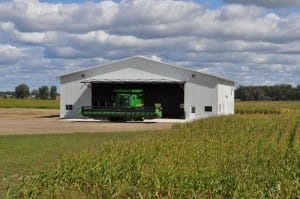
5. Tailor Layout and Dimensions to Your Needs
Try to vividly imagine how you’re going to access the building and use its space. Consider the traffic patterns and the exit/entrance points for people, animals, equipment, supplies—basically anything that will go in (and out) of the structure.
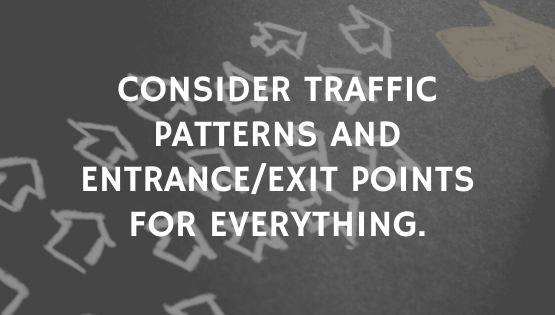
By doing that, you can plan for doorway, ceiling, and room dimensions that are large enough to comfortably accommodate who and what your structure will house.
For example, if you’re planning a building for retail or storage, insert an outside access door that’s 4-feet wide. You’ll avoid scraping your door and trim when using a hand cart to move materials in and out.
Or if you’re building a stall barn, plan your structure width to a 14-foot center aisle between stalls; a 12-foot width could feel cramped.
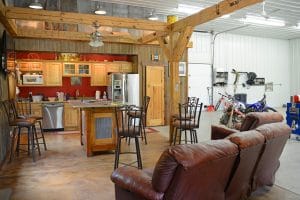
6. Compare Integrated Versus Separated Areas
If your building will have a combination of uses, like a workshop area and a space for lounging, eating, and watching the big game, you’ll probably want to separate those areas with a wall.
This is especially important if you’re going to kick up a lot of dust or chemicals in your workshop. You don’t want any of that getting into your living area. A wall will help keep things neat and clean—and also keep the nasty stuff out of your chili at game time.
On the other hand, an area used to simply park vehicles may not need to be separated from your living space.
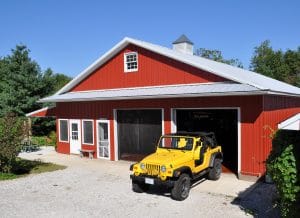
7. Orient the Building Appropriately in Relation to the Sun
Do you want a lot of sunlight on (and in) your building? Or, do you want to reduce the overall amount of sun exposure?
Think about where the sun will hit over the course of a day. Do you want the morning sun to warm up your building? Or, do you want to prevent the afternoon and early evening sun from cooking you, your animals, or your supplies?
Consider these basic tips: Face the front of the shop to the east for early sunlight. If you’re in a warm climate and need some relief from the sun, you may want to orient the front to the north or utilize porches and overhangs to shade windows and walls.
8. Think Beyond the Immediate Future
When deciding where to put the building on your site, consider the possibility for future expansion. Your needs may grow. Your interests may change.
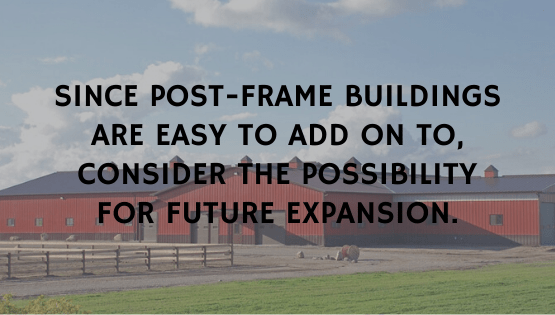
That’s why you should try to leave some space around your building. Since post-frame buildings are easy to add on to, you’ll have the room to do it if, for example, you want to add more office space later on.
Or let’s say you have an equestrian building. Will you always have the same number of horses?
Even if you have no intention of acquiring more, you should plan as if you will. Our experience as builders tells us horse owners usually want more space.
9. Take Condensation Prevention Seriously
Insulation alone will not necessarily prevent condensation within a pole barn. There are cases where the temperatures or humidity levels will be so great between inside and outside that condensation can occur.
And that’s not only bad for your equipment, supplies, and animals; condensation hurts the structure itself.
Preventing moisture from getting into your building in the first place will be your #1 way to stop condensation:
- Build your structure (where possible) in an elevated position with good natural drainage
- Place a vapor retarder under floor (gravel or concrete)
- Ventilate the enclosed building when concrete is being poured and continue to ventilate until it is cured
- Always vent fuel-powered heaters to the outside (in heated buildings)
- Provide adequate drainage of surface water away from the building and provide underground tile to lower the water table, or remove water from gutters draining into the tile
These aren’t the only tactics you can take. Check out How to Prevent Condensation Under a Metal Roof: The Enemy Within for more details.
If you’d like more information on insulation, see Five Tips on How to Insulate a Pole Barn.

10. Plan for Nasty Weather
Your design will greatly affect the stability and lifespan of your pole barn building. Too often, buildings—especially agricultural structures—aren’t properly engineered. And that makes them especially vulnerable when inclement weather strikes.
A chain is only as strong as its weakest link. If some elements of your pole barn building are designed properly for bad weather, but others are not, the building could fail.
For more on this topic, check out Why Do Some Agricultural Buildings Fail To Withstand Inclement Weather?
11. Integrate Proper Engineering Into Your Plans
The above point on weather fits within the larger—and critical—topic of proper engineering. Assessing the wind loads, snow loads, and soil conditions of your building should dictate which building materials you use and how they are engineered to fit together.
Anyone can use strong trusses or columns to construct their building. But construction is about more than the materials you use; it’s about how you put the pieces together.
For instance, your strong truss needs to be properly connected to a strong column. And that column needs to be properly embedded into the ground, or attached to the building’s foundation.
No matter how strong your materials are, if you neglect to engineer them together the right way, your building will not withstand the elements.

12. Start Designing Yourself With the Help of Online Tools
Doodling your building design ideas on a cocktail napkin will only get you so far. It gets tough to picture the layout, the color combinations, and the building elevations from different angles. Besides, at some point, you’ll run out of napkins.
What you need is a way to better visualize things. You also want to bring three dimensions to your post-frame idea so you can better convey it to your spouse, friends, or even a builder. But how?
You don’t have to take a crash course in architecture. It’s easier than ever to start designing with online design tools like Wick Buildings’ DESIGN 3D. Its sole purpose is to make it easy for virtually anyone to create and visualize their very own building.
Just choose a building type and initial design and then start customizing the building to meet your exact needs. In a few easy steps, you can make your post-frame building ideas come to life.
13. Know Your Limits if You Choose the DIY Route
We know there are plenty of options out there if you choose the DIY route for your pole barn building. However, there are also plenty of pitfalls.
We’re not discouraging you from choosing the DIY route—just be sure you know your limits. You can run into serious problems if you:
- Fail to plan thoroughly for every element of project
- Choose a pole barn that’s too complex for your abilities
- Have a crew that’s too small
- Don’t have the right equipment
- Try your hand at trades too difficult to learn quickly
- Fail to see the big picture when planning
- Lack basic but critical experience
- Don’t know specialized building tricks
- Lack the time and money to make mistakes
- Don’t know important safety requirements
For more details, check out How to Avoid a Disastrous DIY Pole Barn Project.
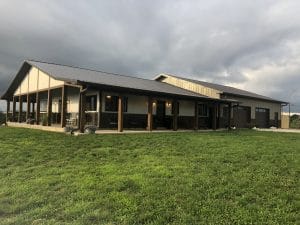
14. Consider a Pole Barn Builder
If there’s one thing the above points should make clear is that a quality pole barn doesn’t build itself. The right design, the appropriate materials, and smart construction practices are essential for a durable, low-maintenance building you’ll enjoy for years to come.
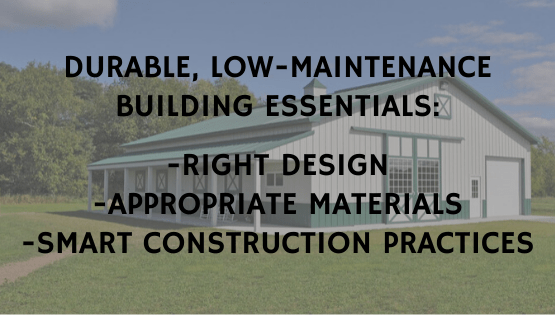
If you’re up to the task of taking the DIY direction, that’s great. We wish you the best and hope that our various online resources can help!
But if you’re not so sure, you do have other options, like working with a qualified pole barn builder. But how do you go about choosing one? You’ll want to consider a number of factors. Here are just a few:
- Find out if they’re accredited by the National Frame Building Association.
- It’s not a necessity, but check if they have a licensed engineer—it’s an indicator of quality.
- Make sure you’ll get an experienced and cohesive crew of three to four workers.
If you want more help in your search, take a look at this helpful post on 14 Things to Look for When Choosing a Pole Barn Builder.


